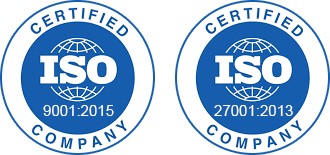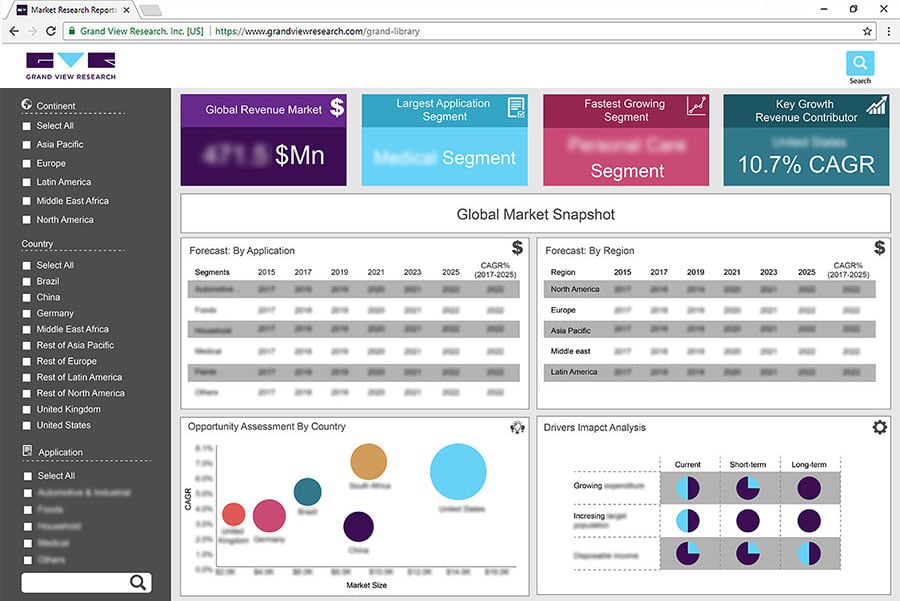- Home
- »
- Pharmaceuticals
- »
-
Actinic Keratosis Treatment Market Size, Share Report, 2030GVR Report cover
![Actinic Keratosis Treatment Market Size, Share & Trends Report]()
Actinic Keratosis Treatment Market Size, Share & Trends Analysis Report By Therapy (Topical, Surgery, Photodynamic Therapy), By Drug Class, By End-use, By Region, And Segment Forecasts, 2023 - 2030
- Report ID: GVR-2-68038-940-1
- Number of Report Pages: 170
- Format: PDF, Horizon Databook
- Historical Range: 2018 - 2021
- Forecast Period: 2023 - 2030
- Industry: Healthcare
Report Overview
The global actinic keratosis treatment market size was estimated at USD 6.4 billion in 2022 and is anticipated to grow at a compound annual growth rate (CAGR) of 4.3% from 2023 to 2030. The market is anticipated to witness growth opportunities owing to factors such as the rising prevalence of Actinic Keratosis (AK) and the wide presence and easy availability of generic drugs for its treatment. Moreover, the market is driven by increasing awareness about actinic keratosis and various strategic initiatives undertaken by industry players. Increasing consumer awareness regarding dermatological diseases, such as actinic keratosis, is a major growth booster for the market.
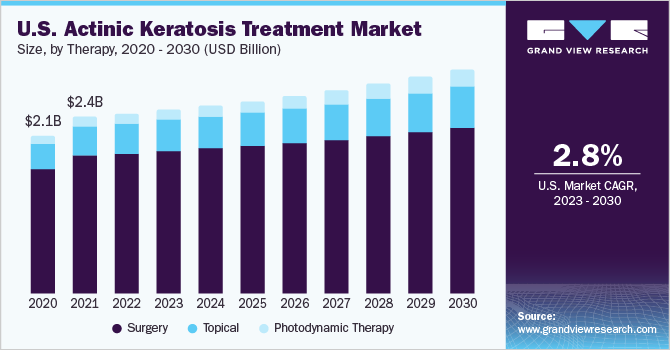
Heightened knowledge about diagnostics and treatment strategies for this disease has driven the widespread adoption of actinic keratosis medications. Several field-directed treatments including 5-fluorouracil, ingenol mebutate, diclofenac, and imiquimod are poised to witness greater market expansion over the next few years. Although the products share similar efficacies, the cosmetic outcomes and adverse effects might differ. Photodynamic therapy was observed to be better than cryotherapy in terms of cosmetic outcomes. Moreover, the easy accessibility and availability of treatments for actinic keratosis are expected to be a significant growth factor for this market.
The prevalence of actinic keratosis is one of the major market drivers. According to an article published by News-Medical.net, an AZoNetwork site in 2019, the prevalence of actinic keratosis is 37% to 55% in Australian adults aged over 40. This is linked to high UV exposure in the Australian population with relatively fair skin. Outdoor sports are very popular in Australia and as a result, they tend to spend their maximum time in the sun. The article further suggests that men are more prone to actinic keratosis than women, but it is also linked to other risk factors such as time spent outside in the sun and overall exposure to the sun. In addition, the overall prevalence of actinic keratosis in the U.S. and the UK is estimated to be 26.5% in males & 10.2% in females, and 6.15% in males and 6% in females, respectively.
The increasing geriatric population across the globe is also anticipated to foster the growth of the market during the forecast period. According to America’s Health Rankings’ Senior Report 2021, it was estimated that more than 54 million adults aged over 65 live in the U.S. and their proportion in the total population accounted for 16.5%. Moreover, according to an article released by Statistics Canada in April 2022, more than 861,000 people in the country were aged 85 and above.
Moreover, actinic keratosis may lead to the development of squamous cell carcinoma, a type of skin cancer, which is expected to drive the actinic keratosis treatment market’s growth in the future. According to the Skin Cancer Foundation, anywhere between 40-60% of squamous cell carcinoma may start as an untreated precancerous lesion of actinic keratosis and 2-10% of cases may progress to Squamous cell carcinoma within the span of two years. This is likely to increase the adoption of the available treatment and early diagnosis of the disease.
Key industry players are adopting strategic initiatives such as product launches, partnerships, and expansion strategies to increase their market share. For instance, in December 2020, Almirall, S.A. announced the U.S. Food and Drugs Administration (FDA) approval of Klisyri (tirbanibulin) for the treatment of actinic keratosis and in September 2021, the company announced the commercial launch of Klisyri (tirbanibulin) in Germany and the UK after receiving approval from the UK’s Medicines & Healthcare Products Regulatory Agency (MHRA) and the European Commission for the treatment of actinic keratosis of the scalp and face in adults.
Therapy Insights
Based on therapy, the market is segmented into topical, surgery, and photodynamic therapy. Surgery held the largest revenue share of 65.6% in 2022. The surgery segment is likely to maintain its dominance during the forecast period owing to higher penetration of cryotherapy for the treatment of actinic keratosis, where actinic keratosis is removed by the application of liquid nitrogen to freeze the affected area causing blistering or peeling. Apart from cryotherapy, curettage, laser therapy, and photodynamic therapy are other types of surgeries.
The photodynamic therapy (PDT) segment is expected to grow at the fastest CAGR of 7.4% over the forecast period from 2023 to 2030. Rising usage of non-invasive therapies and greater efficiency of PDT (photodynamic therapy) in comparison with cryotherapy are factors anticipated to foster the segment’s growth. Photodynamic therapy is a preferred treatment for patients with actinic keratosis relapse.
The topical therapy segment is expected to maintain steady growth due to the rising utilization of self-usage therapy, growing home-based treatments, and various strategic initiatives taken up by market players. In May 2023, FivepHusion, a biotechnology company, announced a strategic partnership with Syneos Health and Treehill partners to promote the development of Deflexifol, a pH formulation used to co-administer chemotherapeutic agent 5-fluorouracil (5-FU) and the biomodulator leucovorin (LV) that improves 5-FU anti-cancer activity. 5-FU creams are used for the topical treatment of actinic keratosis. Other topical options include diclofenac sodium gel,imiquimod cream, and tibanibulin ointment.
Drug Class Insights
Based on drug class, the market is segmented into nucleoside metabolic inhibitors, NSAIDs, immune response modifiers, photoenhancers, and others. Nucleoside metabolic inhibitors held the largest revenue share of 32.4% in 2022. The growth is attributed to the strong commercial performance of Efudex, Carac, and Fluoroplex. Moreover, the increased awareness regarding actinic keratosis treatment and diagnosis has fueled the growth of the segment.
The growth of the nucleoside metabolic inhibitors segment is also augmented by various strategic initiatives taken up by the industry players. For instance, in June 2020, Hill Dermaceuticals, Inc., a leader in dermatological products, announced that its product, Tolak (Fluorouracil) 4% Cream, has been successfully registered in 13 countries of Europe including the UK, France, Belgium, and Italy.
The photoenhancers segment is anticipated to grow at the fastest CAGR of 8.4% over the forecast period from 2023 to 2030 and is expected to witness robust growth opportunities owing to factors such as rising awareness about actinic keratosis treatment, various strategic initiatives undertaken by market players, and a surge in the use of photoenhancers such as Photofrin, Metvix, and Levulan.
End-use Insights
Based on end-use, the market is segmented into hospitals, private clinics, homecare, and others. The hospitals segment held the largest share of 30.4% in 2022. This is attributed to factors such as treatment rate accessibility, availability of healthcare facilities, and rising photodynamic therapy procedures performed in hospitals. Several prescription medicines are available that are used in performing photodynamic therapy. LEVULAN and KERASTICK are prescription medicines manufactured by DUSA Pharmaceuticals, Inc. and are used on skin with blue light treatment (PDT) for the management of minimally to moderately thick actinic keratosis of the scalp, upper arms, and face.
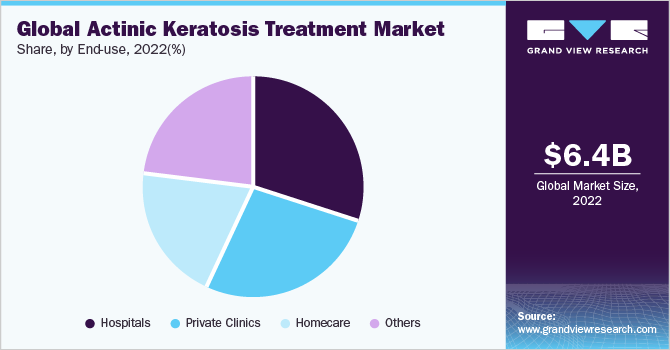
The homecare segment is expected to grow at the fastest CAGR of 5.2% during the forecast period owing to the rising adoption of topical products, patient convenience factors, availability of OTC products, and the increasing launch of products for topical use. Moreover, the homecare segment has witnessed an increased demand due to the rising availability of topical products. For instance, Tolak 4% cream manufactured by Hill Pharmaceuticals is a topical prescription medicine used to treat skin lesions of actinic keratosis, and Zyclara, manufactured by Bausch Health Companies Inc., is an imiquimod cream used for the topical treatment of actinic keratosis.
Regional Insights
North America dominated the market with the largest revenue share of 41.5% in 2022 and is anticipated to maintain its dominance over the forecast period. This can be attributed to the rising prevalence of actinic keratosis, favorable government initiatives, rising consumer awareness, improvements in healthcare infrastructures, and ongoing technological advancements. The presence of key players is also one of the key factors responsible for the regional growth.
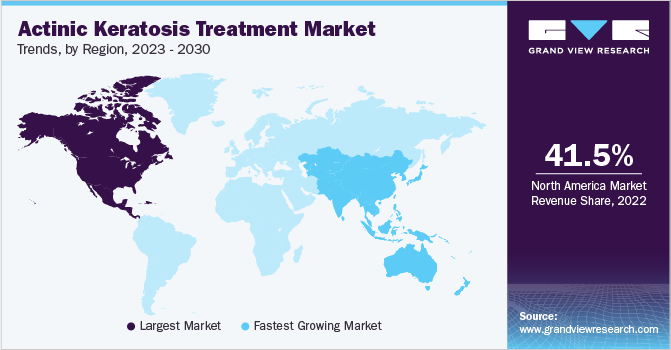
In addition, favorable government initiatives and reimbursement policies are expected to boost industry growth. According to the information updated by Cleveland Clinic in December 2020, 58 million Americans are diagnosed with single as well as multiple actinic keratosis spots. Furthermore, according to the Canadian Skin Cancer Foundation, 60% of Canadians above the age of 40 have at least one actinic keratosis spot on their skin.
In June 2023, Biofrontera Inc. announced its The Sun Bus sponsorship. It’s a mobile clinic and classroom offering public education and free skin cancer screening to communities in the U.S. Biofrontera is committed to enhancing AK lesions treatment that are premalignant, however, if left untreated, may lead to squamous cell carcinoma.
Asia Pacific is expected to grow at the fastest CAGR of 5.6% during the forecast period. An increase in the adoption of treatment, rising consumers’ disposable income, and high disease prevalence in some nations, such as Australia and New Zealand, are some of the key factors driving the regional growth. According to the information published by the International Agency for Research on Cancer (IARC) in 2020, a subsidiary of the World Health Organization (WHO), the age-standardized mortality rate (ASR) world of Asian countries due to melanoma of skin is 9.3, 3.8, and 1.5 for Israel, Georgia, and Turkey, respectively. China’s ASR was 0.31, India’s 0.24, and Japan’s 0.42 in the same year.
Key Companies & Market Share Insights
The presence of a large number of companies and a strong product portfolio is expected to a strong market share for the companies. The market is highly competitive due to the presence of a large number of industry players worldwide. Moreover, various organic and inorganic developments undertaken by players are anticipated to fuel industry growth during the forecast period.
For instance, in April 2022, Almirall S.A. announced a research collaboration with the University of Dundee to develop novel approaches for common and chronic dermatological disorders. In addition, they declared May 24th as Actinic Keratosis Global Day in 2022, in collaboration with Euromelanoma and AEDV Fundacion Piel Sana, to increase awareness about the disease.
In February 2022, Jupiter Wellness announced the completion of the recruitment of the JW-200 clinical trial. It is a dual mechanism of action cox 2 inhibitors comprising aspartame and cannabidiol offering rapid relief and efficacy in AK lesions, also being skin cancer treatment. Some prominent players in the global actinic keratosis treatment market include:
-
Almirall S.A.
-
LEO Pharma A/S
-
Sun Pharmaceutical Industries Ltd.
-
Novartis AG
-
GALDERMA
-
Ortho Dermatologics (Bausch Health Companies Inc.)
-
BIOFRONTERA AG
-
Hill Dermaceuticals, Inc.
Actinic Keratosis Treatment Market Report Scope
Report Attribute
Details
Market size value in 2023
USD 6.7 billion
Revenue forecast in 2030
USD 8.9 billion
Growth rate
CAGR of 4.3% from 2023 to 2030
Base year for estimation
2022
Historical data
2018 - 2021
Forecast period
2023 - 2030
Report updated
September 2023
Quantitative units
Revenue in USD million/billion and CAGR from 2023 to 2030
Report coverage
Revenue forecast, company ranking, competitive landscape, growth factors, and trends
Segments covered
Therapy, drug class, end-use, region
Regional scope
North America; Europe; Asia Pacific; Latin America; MEA
Country scope
U.S.; Canada; UK; Germany; France; Italy; Spain; Denmark; Sweden; Norway; China; Japan; India; Australia; South Korea; Thailand; Brazil; Mexico; Argentina; Saudi Arabia; South Africa; UAE; Kuwait
Key companies profiled
Almirall S.A.; LEO Pharma A/S; Sun Pharmaceutical Industries Ltd.; Novartis AG; GALDERMA; Ortho Dermatologics (Bausch Health Companies Inc.); BIOFRONTERA AG
Customization scope
Free report customization (equivalent up to 8 analyst’s working days) with purchase. Addition or alteration to country, regional & segment scope
Pricing and purchase options
Avail customized purchase options to meet your exact research needs. Explore purchase options
Global Actinic Keratosis Treatment Market Report Segmentation
This report forecasts revenue growth at global, regional, and country levels and provides an analysis of the latest industry trends in each of the sub-segments from 2018 to 2030. For this study, Grand View Research has segmented the global actinic keratosis treatment market report based on therapy, drug class, end-use, and region:
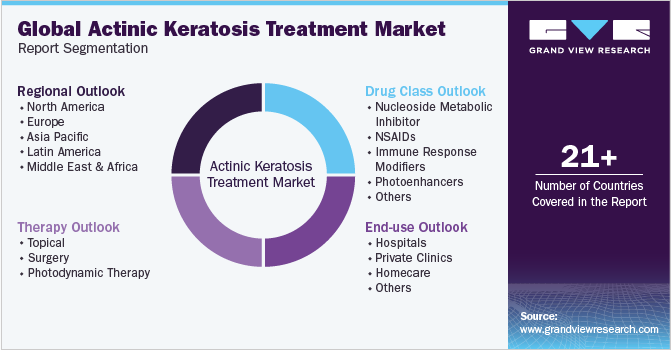
-
Therapy Outlook (Revenue, USD Million, 2018 - 2030)
-
Topical
-
Photodynamic Therapy
-
Surgery
-
-
Drug Class Outlook (Revenue, USD Million, 2018 - 2030)
-
Nucleoside Metabolic Inhibitor
-
NSAIDs
-
Immune Response Modifiers
-
Photoenhancers
-
Others
-
-
End-use Outlook (Revenue, USD Million, 2018 - 2030)
-
Hospitals
-
Private Clinics
-
Homecare
-
Others
-
-
Regional Outlook (Revenue, USD Million, 2018 - 2030)
-
North America
-
U.S.
-
Canada
-
-
Europe
-
UK
-
Germany
-
France
-
Italy
-
Spain
-
Denmark
-
Sweden
-
Norway
-
-
Asia Pacific
-
Japan
-
China
-
India
-
Australia
-
Thailand
-
South Korea
-
-
Latin America
-
Brazil
-
Mexico
-
Argentina
-
-
Middle East and Africa
-
South Africa
-
Saudi Arabia
-
UAE
-
Kuwait
-
-
Frequently Asked Questions About This Report
b. The global actinic keratosis treatment market size was valued at USD 6.4 billion in 2022 and is expected to reach USD 6.6 billion by 2023.
b. The global actinic keratosis treatment market is expected to grow at a compound annual growth rate of 4.3% from 2023 to 2030 to reach USD 8.9 billion by 2030.
b. Surgical therapy led the actinic keratosis treatment market in 2022 with a market share of 65.0%, high penetration of cryotherapy for the treatment of AK is responsible for a high share of the surgery segment.
b. Some key players in the actinic keratosis treatment market include Almirall, S.A, Bausch Health Companies Inc., Biofrontera, and LEO Pharma A/S among others.
b. Increasing prevalence & incidence of disease coupled with an increasing geriatric population and increasing awareness about the disease are factors expected to drive the growth of the actinic keratosis treatment market over the forecast period.
Share this report with your colleague or friend.
![gvr icn]()
NEED A CUSTOM REPORT?
We can customize every report - free of charge - including purchasing stand-alone sections or country-level reports, as well as offer affordable discounts for start-ups & universities. Contact us now
![Certified Icon]()
We are GDPR and CCPA compliant! Your transaction & personal information is safe and secure. For more details, please read our privacy policy.
We are committed towards customer satisfaction, and quality service.
"The quality of research they have done for us has been excellent."
